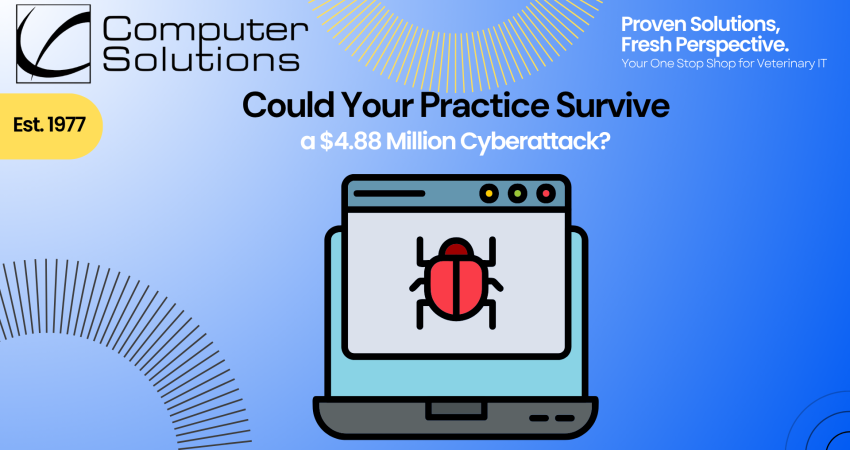
Posted by Computer Solutions on August 11, 2025
Most veterinary clinics don’t think of themselves as targets for cybercriminals. After all, you’re not a massive hospital system or a multinational corporation. But here’s the uncomfortable truth: small businesses are now the most common targets in the cybersecurity landscape.
Why? Because they’re easier to access, less likely to have advanced protections in place, and more likely to pay a ransom quickly just to get back to work.
According to IBM’s 2024 Cost of a Data Breach Report, the average cost of a single breach is now $4.88 million. That number includes downtime, customer loss, legal fees, ransom payments, and the long-term impact on reputation and trust.
Most small businesses—including veterinary practices—can’t absorb a hit like that. The question is: are you doing enough to prevent one?
Traditional Antivirus Isn’t Enough
You may already have antivirus software installed on your office computers. Maybe even a firewall. And that’s a good start.
But traditional antivirus only detects known threats. If a new form of malware slips through or if a hacker logs in using stolen credentials, those tools won’t always catch it. And when seconds matter, a slow response can be the difference between a small incident and a major crisis.
That’s why more businesses are turning to a tool called endpoint detection response (EDR)—and it’s quickly becoming the new standard in real-world cybersecurity.
What is Endpoint Detection and Response?
Think of EDR as your digital security guard. Instead of simply scanning for threats periodically, it constantly monitors what’s happening on your workstations, laptops, and servers in real time.
Here’s what sets EDR apart:
- It watches every process and system interaction
- It detects suspicious behavior, not just known malware signatures
- It can automatically isolate an infected machine before the damage spreads
- It provides detailed insight into how the threat entered and what it touched
In short, it doesn’t just protect your devices—it gives you visibility, control, and the ability to respond quickly.
For a veterinary clinic, where patient data, imaging files, and payment information live on the network, endpoint detection response can mean the difference between an early warning and a full-blown breach.
Why Now?
Cyberattacks are no longer about flashy hackers running brute-force attacks. Modern attackers use social engineering, credential theft, and software disguised as routine files. Some even sit quietly in a network for days or weeks before acting.
They don’t break in—they log in.
One misplaced click from a team member, or a compromised vendor connection, and suddenly ransomware is spreading through your systems. By the time it’s visible, the damage is already done.
EDR gives your clinic the ability to detect and shut down threats before they escalate. And in a world where cybercriminals are increasingly targeting small businesses, that speed matters.
Insurance Providers are Paying Attention
Another key reason to implement endpoint detection response: your cyber insurance policy may require it.
Insurers are tightening their standards. They want to see more than basic antivirus software or backup tools. They want evidence of proactive threat detection, credential protection, and secure response protocols. Without those tools in place, your claim could be reduced—or denied entirely.
Think of EDR like a smoke detector in your building. You hope you never need it. But try explaining to your insurer that you didn’t install one after a fire.
How Do You Know If You Have EDR?
That’s a common question—and one we’re happy to help answer.
Some IT providers say they “monitor your systems,” but that doesn’t always mean endpoint detection and response is in place. If you’re not sure, ask your provider:
- Do we have EDR on every workstation and server?
- Can you show me how it works and what it’s caught recently?
- How quickly would we be alerted if ransomware started spreading?
If the answers are unclear or overly technical, it’s worth taking a closer look.
The Bottom Line
The average data breach costs $4.88 million. Even a small breach—if it disrupts your practice, exposes client data, or leads to a compliance review—can be enough to cause lasting damage.
But the solution doesn’t have to be complicated.
With the right protections in place, including endpoint detection response, you can drastically reduce your clinic’s risk, stay compliant with insurance requirements, and sleep better knowing that your systems are being watched even when you’re not at the office.
Let’s Review Your Cybersecurity Setup
If you’re not sure whether your clinic could survive a modern cyberattack, it’s time to find out—without the jargon, the guesswork, or the pressure.
Schedule a free cybersecurity assessment at welinku.com today. We’ll show you what’s in place, what’s missing, and how to make your clinic a harder target.
Want to learn more about veterinary IT and cybersecurity? Check out another blog post here!
Discover more from Computer Solutions
Subscribe to get the latest posts sent to your email.







